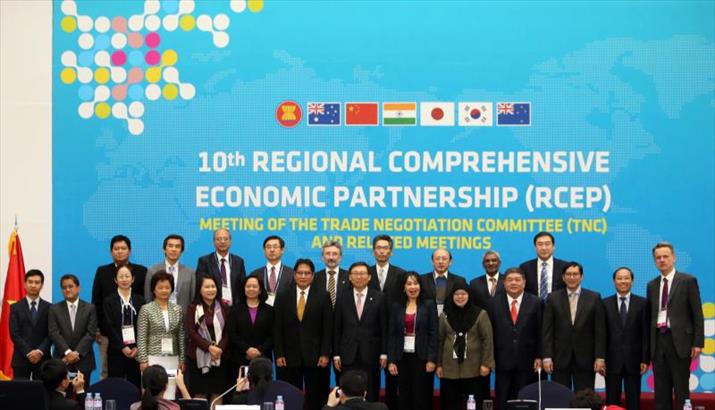| Opinion |
| New Opportunities under RCEP | |
| The early completion of the agreement will bring new opportunities for China-India economic and trade relations | |
|
|
 The 10th round of RCEP negotiations underway in Busan, South Korea, on October 12, 2015. More than 700 representatives from 16 countries including South Korea, China, Japan and Australia participated in the negotiations (IC)
It is still too early to determine whether the U.S. Congress will endorse the withdrawal from the TPP. It's likely that two regional trade agreements, the TPP and the Regional Comprehensive Economic Partnership (RCEP), will both be implemented in the Asia-Pacific region. At the same time, the wave of adjustment to international trade and investment rules, stirred up by the Transatlantic Trade and Investment Partnership (TTIP) and the Trade in Services Agreement (TISA), is becoming yet another major external factor that impacts the economic development of Asia-Pacific countries.How to optimally balance the relationship between the TPP and the RCEP, and the relationship between global trade standards and actual conditions in Asia, has become a crucial issue for Asia-Pacific nations, especially China and India. The two biggest emerging economies in the world are beginning to engage in deeper cooperation to safeguard their positions in regional and global economic governance. Compared to the TPP, which mandates "rigorous and extremely high standards" and is plagued with uncertainty, the RCEP seems more feasible. The early completion of the RCEP will provide a new path and platform for China to integrate with South Asia and for India to better integrate with the Asia-Pacific region.  India businessmen talk to an exhibitor (first right) from east China's Zhejiang Province at an e-commerce pioneer park in Helan County, Yinchuan City, Ningxia Hui Autonomous Region, on July 17, 2016 (XINHUA)
Regional economic cooperation The RCEP is a trade initiative proposed by the Association of Southeast Asian Nations (ASEAN) that involves the group's 10 member states and six free trade agreement (FTA) partners: Australia, China, India, Japan, South Korea and New Zealand. RCEP negotiations, launched in 2012, have gone through 16 rounds and are now in the final stage. The 16 participants have reached consensus on issues such as tariff reduction, exemptions for tangible goods, rules of origin, technical barriers to trade, sanitary and phytosanitary measures, customs procedures and trade facilitation. All that remains is the discussion of services, trade and investment, which leaves RCEP negotiations in a substantive bargaining stage. Even though many involved parties are still quarreling over issues such as tariff reduction on sensitive products and market entry in sensitive sectors, the completion of the RCEP is a matter of when, not if. Upon implementation, the RCEP will serve as a free trade agreement with ASEAN at its core. The combined population of the 16 member countries is more than 3.5 billion, about 48 percent of the world population, and the combined GDP amounts to $22.7 trillion, about 30 percent of global GDP. The combined trade volume of these countries is $9.58 trillion, about 29 percent of the world's total. Unlike the TPP, which emphasizes unified standards and rules, the RCEP is based on the effective international division of labor and the well-developed regional manufacturing network in the Asia-Pacific region. The economic returns and social benefits of the RCEP are mostly found in the reduction of non-tariff barriers and increased output. Affected industries and sectors will gain advantages from trade and investment liberalization via the free trade initiative. A report released by the Asian Development Bank predicts that by 2025, the RCEP will create economic benefits of $644 billion and accelerate China and India's GDP by 1.45 percent and 1.74 percent, respectively. With the TPP mired in uncertainty and the WTO multilateral trade process at a standstill, the RCEP, when implemented, will fundamentally change the landscape of Asia-Pacific cooperation.
Tremendous potential China and India together account for 17.9 percent of global GDP and 13.2 percent of world trade as well as 58.9 percent of the total GDP of RCEP members and 47.4 percent of the group's combined trade volume. Both ancient civilizations are members of BRICS and the Shanghai Cooperation Organization (SCO), and the two countries share similar natural and cultural resources, though each has its own unique advantages. Trade facilitation and investment liberalization within the RCEP framework will bring new opportunities and consolidate the continued development of China-India economic and trade relations. This relationship will set an example for bilateral cooperation, using existing comparative advantages to create new ones. Services and investment have recently been the focus of international trade negotiations. Both are expected to become important growth points for China-India economic cooperation, which will not only facilitate the formation of new manufacturing chains at the bilateral level as well as between each of the two countries and other RCEP members, but also ensure continuous growth in bilateral trade and investment. Statistics from the United Nations Conference on Trade and Development show that by the end of 2015, China and India had accumulatively received foreign direct investment (FDI) of $1.2 trillion and $282.27 billion, respectively, and the combined FDI they received accounted for 6 percent of the global total and 36.2 percent of the total FDI flowing into RCEP members. By the end of 2015, China and India's accumulative outbound direct investment (ODI) had reached $1.1 trillion and $138.97 billion, respectively, and their combined ODI made up 4.6 percent of the global total and 28.9 percent of the RCEP total. In 2015, China and India's trade in services reached $755.44 billion and $278.95 billion, respectively, and their combined volume in this regard accounted for 10.8 percent of the global total and 44.4 percent of the RCEP total. All this indicates that the two countries occupy vital positions in regional and global investment and trade in services. Even though both countries have witnessed rapid growth in their shares of global trade and investment, trade and investment between China and India remains comparatively small. According to China's Ministry of Commerce, by 2015, China's direct investment in India had amounted to $3.77 billion, accounting for only 0.34 percent of the country's total investment abroad and 1.34 percent of total FDI in India. The International Monetary Fund (IMF) estimated that by the end of 2014, India's total investment in China was only $313 million, accounting for 0.34 percent of its total investment abroad and 0.03 percent of total FDI in China. There is tremendous potential for the two countries to increase mutual trade and investment. China-India cooperation After more than three decades of reform and opening up, China has become one of the most vigorous economies in the world. Its GDP rocketed from $302.94 billion in 1980 to $11.2 trillion in 2015, an average annual increase of 10.9 percent. Over the same period, its proportion of global GDP grew from 2.5 percent to 14.9 percent. Meanwhile, India's GDP grew from $181.12 billion in 1980 to $2.2 trillion in 2015, an average annual growth rate of 7.4 percent, increasing its proportion of global GDP from 1.5 percent to 3 percent. IMF statistics show that in 2015, China and India contributed 36.7 percent and 16.5 percent, respectively, to world economic growth. Meanwhile, the contribution of the United States and Japan were 12.3 percent and 0.7 percent, respectively. As two large developing economies, China and India are expected to maintain long-term growth at a medium to high speed and, along with other emerging economies, remain important engines for global growth. The rapid economic growth of China and India is changing the global economic and trade structure, as well as providing new opportunities for the two countries to expand mutually beneficial, win-win cooperation. China and India complement each other in fields such as services, investment, high-end manufacturing and infrastructure, and see tremendous potential for cooperation in improving trade imbalances, combating trade protectionism and building a more rational and mutually complementary trade structure. They also share common interests in terms of regional and global cooperation and traditional and non-traditional security. Considering their enormous economic sizes and important positions in the global value chain and industrial chain, China and India should give full play to their respective geographic and economic advantages to facilitate the completion of the RCEP as soon as possible. In turn, the RCEP will provide institutional backing for their trade and investment cooperation with one another as well as with other RCEP members. The function of the RCEP in promoting trade, facilitating investment, fine-tuning industry and facilitating the resulting spillover effects will further improve the manufacturing network, expand the value chain and optimize allocation of trade and production factors in the Asia-Pacific region. This will create new opportunities for every country in the region. Freer flow of goods and resources helps balance development between various countries. Shrinking economic gaps between China and India as well as between the two countries and other RCEP members in favor of more balanced regional development, improved living standards and sustainable economic growth meet both Chinese and Indian demands for common development and regional economic integration. Copyedited by Dominic James Madar Comments to zhouxiaoyan@bjreview.com |
|
||||||||||||||||||||||||||||
|